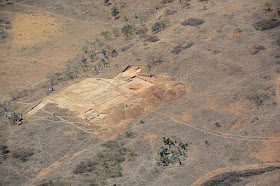A palace complex believed to be the home and business center for the ruler of an ancient empire dating back to over 2,000 years has been discovered in Mexico. The palace has been dated to approximately 2,100 to 2,300 years ago, a time before the Aztecs, researchers said.
The palace is well preserved and covered about 2,790 square meters. The construction techniques used by the builders suggest the building was designed ahead of time and that it was likely a single construction effort that would have taken a lot of organization, researchers said.
Its large size demonstrated that the ruler had a lot of manpower at his disposal. The researchers also note that personal details are still evident in some parts of the palace, such as the cistern for collecting rainwater in the residential quarters and the drain carved into stone to bring in fresh water and remove waste.
The civilization that existed in Oaxaca is believed to be among the earliest states to come into existence in Mesoamerica. Researchers Elsa Redmond and Charles Spencer of American Museum of Natural History suggest that their findings at the palace site backs up that theory.
The Oaxaca Valley near the southern tip of Mexico has been offering up clues of past civilizations for several decades – a team has been working at the El Palenque site in particular since 1993, ‘Phys.org’ reported.
The El Palenque palace exhibits certain architectural and organizational features similar to the royal palaces of much later Mesoamerican states described by Colonial-period sources, researchers said. The royal palace was multi-functional and had courts and buildings for government officials to conduct state affairs as well as residential quarters for the rulers, according to the paper which is published in the Proceedings of the National Academy of Sciences. It also had a staircase, dining area and space to perform sacrifices. There are even personal details in parts of the palace such as a cistern for collecting rainwater and a stone drain to bring in fresh water and remove waste.
Using radiocarbon dates, researchers found that the palace was built in a single construction effort during 300-100BC.


No comments:
Post a Comment